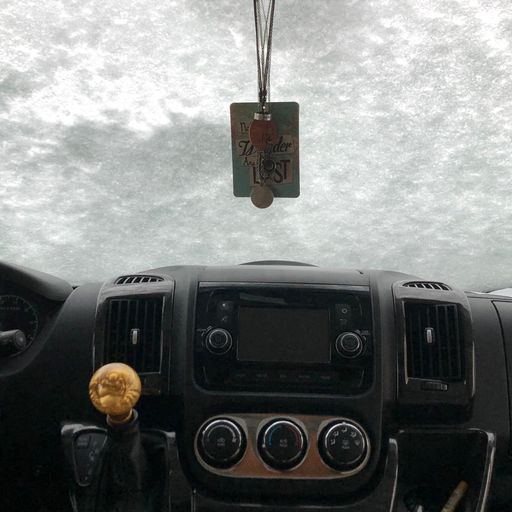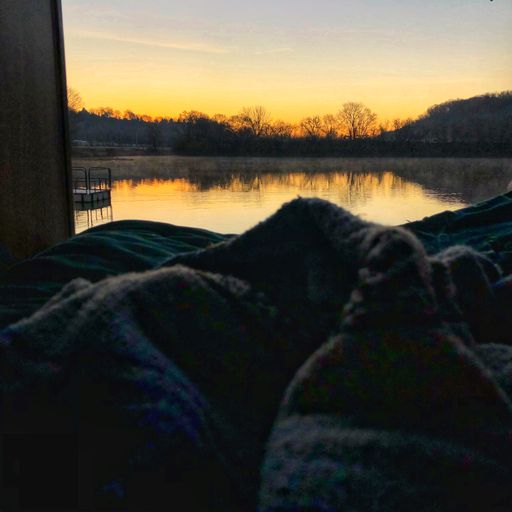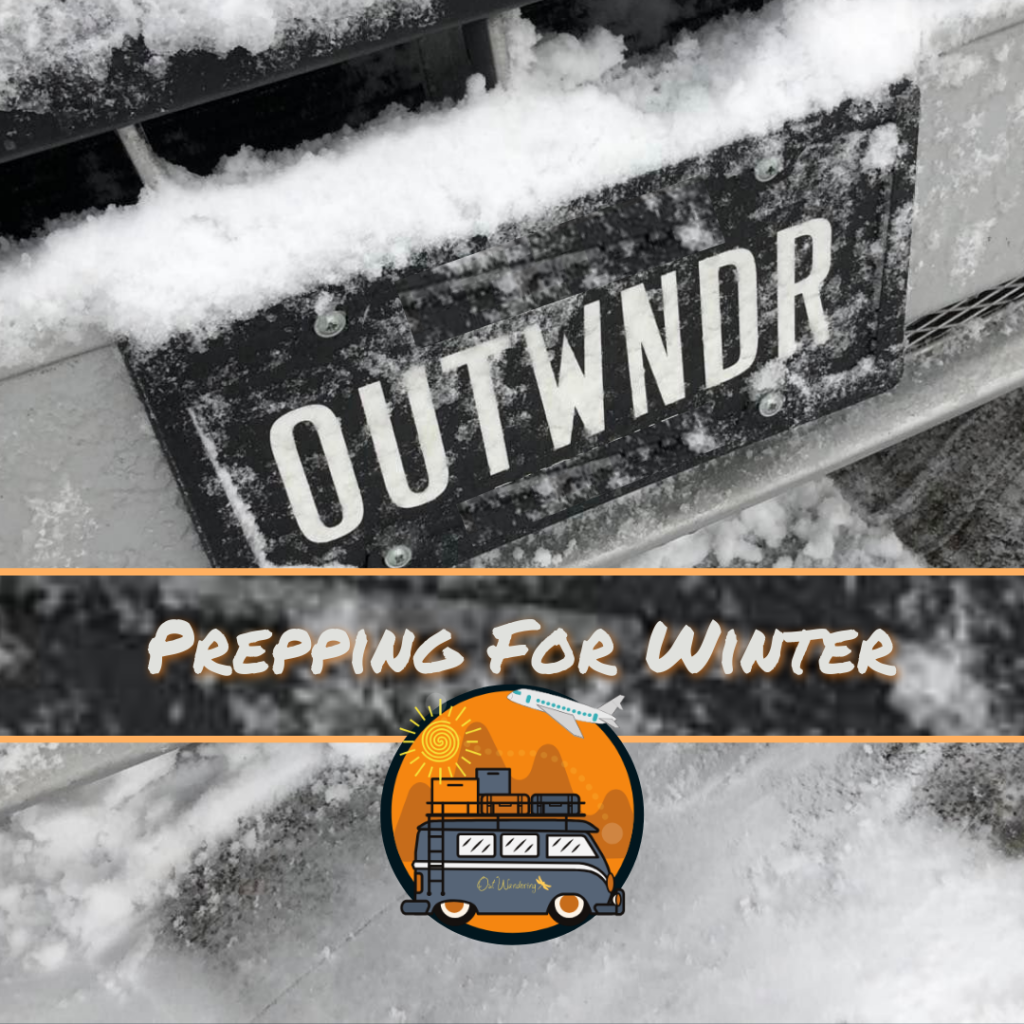Some might consider this way of living for a long weekend; maybe others could travel this way for two weeks – but me? I choose full-time van living because it allows me to change my view at any time; it offers flexibility and mystery and keeps me a little uncomfortable – shaking up the routine that can happen along life’s journey.
Vanlife: Prepping For Winter
Winter Is Here
Let’s be honest, wintertime in a van can be challenging, and most RVers prefer to move with the seasons, finding milder temperatures and weather conditions to live in. Until I can do this, too, winter prepping remains a must.
Most of the time, vans are not well-insulated, and water lines can freeze, causing damage when the temperatures drop too low. However, if you’d like to live the way I do, it’s essential to know how to prepare yourself and your van for the midwest winters. This article gives some tips for prepping to live in a Class B Van for the cold weather months.
Sometimes the only way to find yourself is to get completely lost.
Unknown

Stay or Go
Deciding to live in a van in one location during the winter is a different experience than actively traveling through it. When you’re stationary, you will most likely have access to hookups and more ways to prepare your van.
But, if you’re are like me and enjoy moving around to as many new overnight spots as much as possible, exploring the areas around you, the take-away from this article is not to be caught off guard – it’s necessary to plan for snow and freezing temperatures.
Say Goodbye To Running Water
For those of you who may not know, one part of prepping to live in the brutal midwest winter is adding RV antifreeze to all inner pipes, tanks and macerators – including the grey and black holding tanks.
Although I am grateful for this whole experience every day, the winter prep signifies no more running water for this van-girl! I will be onboarding water for everything now – drinking, cooking and bathing, from Thanksgiving until Easter.

Running water does make life easier when living in a van.
On the surface, it might not sound like fun to live in a winterized van for the long cold months. But, for me, the many enjoyable components of living this way far outweigh the few inconveniences. Being creative, I’ve managed to keep the water “flowing” during the cold weather for all of my needs.
Learning To Winterize
Being self-sufficient is crucial to my way of life. One way of adapting is to do as much as possible on my own. Learning how to winterize my van has eliminated the time and expense of using a dealer’s shop. It also makes it easy and inexpensive to un-winterize in a flash if I find myself in warmer climates. There are a lot of tutorials on this topic. This one with Ben from Lichsinn RV has been my go-to.
Water Jugs
So what does it mean not to have access to running water? When temps are above 32 degrees, there is a 21-gallon water tank that I fill and use. Another winder adaptation is to onboard gallon-sized water jugs – heating water in a kettle on the stove for cooking and chores.
One sure thing about water held like this in the winter is that it’s already ice-cold for refreshing drinks.
Fun Fact: Did you know the average person in the U.S. uses 82 gallons of water each day? I don't consider myself an environmentalist, but I am proud to say my water consumption has decreased to about five gallons per day by living the way I am.
Plant-Based Products
What do I do with the used water, you may ask? Throwing dirty water with certain chemicals onto the ground is be bad for the environment, so I use only plant-based products like Meyers for dishwashing and cleaning and Love Beauty and Planet body products.
Staying Warm In The Van
Baby, It’s Cold Outside! You would think that heating the inside of my van would be simple, right? After all, heating a home is usually pretty straightforward – you press a button, and warmth happens.
My van is equipped with an energy-saving Truma Combi™ Eco Plus Heating System and a small six-gallon propane tank. It does a great job keeping me warm, but the trick can be to find a place to fill in the deep freeze of winter – especially if I am boondocking.
During those cold weeks in 2021, all of my usual fill-up places had closed because the cold weather had frozen their equipment, but Three Rivers FS saved the day – I just needed to be on their parking lot before the drivers left at 7:00 AM.
Electric Heaters
In addition to using the onboard propane heat, I use a small space heater to help keep me warm. Just like in a traditional home, I can only live in one part of the van at a time. When I am in the front space, eating or working at the table,
I conserve my propane and use the Comfort Glow Oscillating Ceramic Safety Furnace. To use this, I need to be connected to a shore power source (electrical outlet) or using a generator. I like it because if it tips, it will turn off – it doesn’t have a very good handle, though and can be awkward when moving.

Insulate the Windows
Insulating windows is another way to keep it warmer inside the van. Even though the dual-pane acrylic windows and European-styled cassette shades offer a thermal break for insulation, some cold still gets through on frigid nights.
I’ve tried different types of window insulation, but I use this wool creation as it allows me to roll it up when it’s not in use. Wool’s natural structure makes it incredibly effective as an insulator. It has to be ‘rock-the-van’ windy to feel any airflow coming from my windows now.
I Can’t Tell – Is Van Girl In There? Thermal curtains are another way to keep my van warm without losing any decor points. I use two heavy-duty curtains layers between the cab and my living space.
They are great for both winter and summer temperatures. And, when I am driving, the cab heater/air-conditioner doesn’t have to work extra hard to keep the whole van comfortable.
Before You Go
Plug-In Whenever Possible To stay warm and comfortable, I try to plug into electricity whenever possible. Sometimes I stop at a campground or moochdock on a friend’s driveway – either way, any 30 amp or 110 outlet is appreciated when temps get below zero.
February 2021 was my first extended exposure to sub-zero temperatures in the van. For over two consecutive weeks, the midwest experienced negative temps and wind. It was an endurance test for sure. I am ever grateful for my mom and others who let me plug in to stay warmer.
Solar Panels and Generators No matter how you explore, having solar panels and a generator are always great investments. They enhance power for your rig when boondocking or just pulling off the to work or enjoying some lunch.
They can be extremely helpful in emergencies and weather-related situations too. You never know when you might get caught in a snowstorm, and pulling into a parking lot is the only safe plan.
Have you camped in an RV during the winter or been caught in a snowstorm while traveling? Share your stories in the comments below.
Share this post
I hope the photos, stories and conversations on this blog will plant a seed, inspire a trip or maybe even create a ripple that leads to a lifestyle change of your own.
Life is short, and our world is meant to be explored. I hope this article will inspire an adventure for you. Cheers to your journey – wherever it may lead!
Share this post

Kirsti Out Wandering aspires to illustrate well-being in mind, body & spirit, giving unconditional love to self and others, and pursuing all of the wild possibilities life serves up while living full-time from a sprinter van.
Follow along! Be sure to sign up for my monthly newsletter filled with stories and tips on travel, exploring, van-living, self-care & yoga, photography and life on the road.

